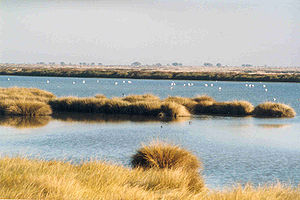Do?ana National Park is a natural reserve in Andalusia, southern Spain, in the provinces of Huelva and Seville. It covers 543 km2 (209.65 sq mi), of which 135 km2 (52.12 sq mi) are a protected area. The park is an area of marshes, shallow streams, and sand dunes in Las Marismas, the delta where the Guadalquivir River flows into the Atlantic Ocean. It was established as a nature reserve in 1969 when the World Wildlife Fund joined with the Spanish government and purchased a section of marshes to protect it. The eco-system has been under constant threat by the drainage of the marshes, the use of river water to boost agricultural production by irrigating land along the coast, and the expansion of tourist facilities. It is named after Do?a Ana de Silva y Mendoz, wife of the seventh Duke of Medina-Sidonia.Do?ana National Park has a biodiversity that is unique in Europe, although there are some similarities to the Camargue river delta in France, which contains the Parc Naturel R?gional de Camargue, with which Do?ana Park is twinned. The park features a great variety of ecosystems and shelters wildlife including thousands of European and African migratory birds, fallow deer, Spanish red deer, wild boars, European badgers, Egyptian mongooses, and endangered species such as the Spanish Imperial Eagle and the Iberian Lynx.The Do?ana nature reserve includes both the Do?ana National Park, established in 1969, and the Natural Park, created in 1989 and expanded in 1997, creating a buffer zone of protection under the management of the regional government. The two parks, national and natural, have since been classified as a single natural landscape. Due to its strategic location between the continents of Europe and Africa and its proximity to the Strait of Gibraltar, Do?ana's large expanse of salt marsh is a breeding ground as well as a transit point for thousands of European and African birds (aquatic and terrestrial), and hosts many species of migratory waterfowl during the winter, typically up to 200,000 individuals. Over 300 different species of birds may be sighted there annually. Considered the largest nature reserve in Europe, several different scientific institutions have monitoring stations within its boundaries to ensure appropriate development of adjacent lands and conservation of the threatened species that inhabit it. The area was declared a World Heritage Site by Unesco in 1994; in 2006 the park recorded 376,287 visitors.During the 19th and 20th centuries, a herd of feral dromedaries roamed the area. They may have been introduced during the Moorish Conquest of Spain in the 8th century, or they may have escaped from a herd introduced by the Marquis de Molina as beasts of burden in 1829. By the 1950s, there were only eight individuals left, and these were threatened by poachers.

Superficie total (m2)
543000000.000000
Categorías de la IUCN (Unión Internacional para la conservación de la naturaleza)
II
Ubicación
Spain
Huelva
Province of Seville



Aipatu
0